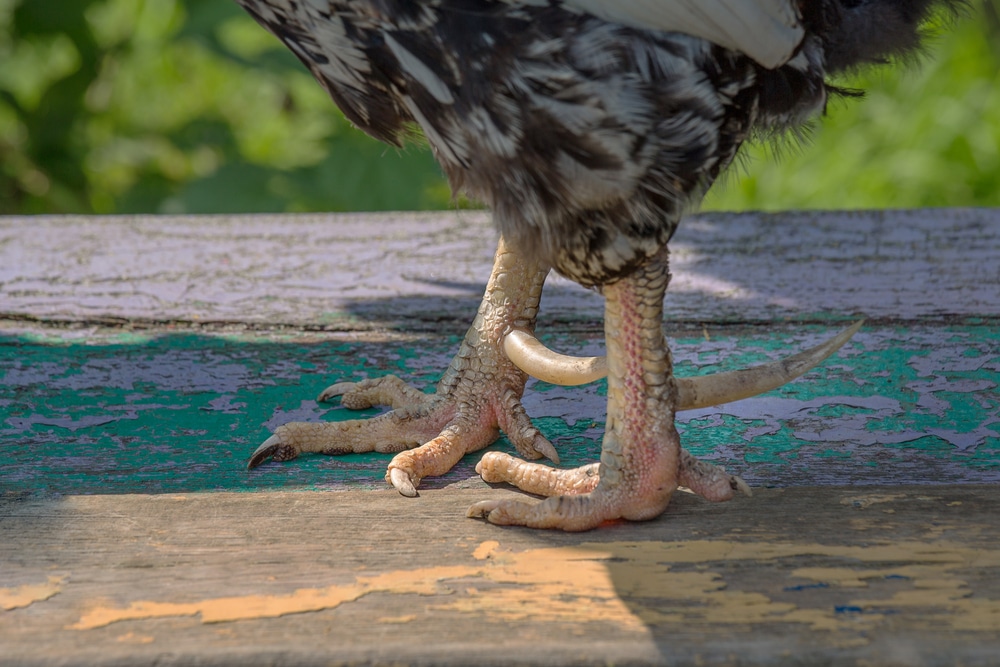If you’ve ever spent any amount of time around a rooster, you’ve probably noticed the sharp, scary-looking protrusions on the rooster’s leg. They’re rooster spurs.
Rooster spurs are natural features that are found on every single rooster, and despite that fact, the idea of a rooster’s spurs is still something that is feared by just about every chicken keeper.
And for good reason, too. Spurs are not only scary-looking, but they have the ability to initiate a fatal blow to another chicken or even to inflict a serious injury upon you, the chicken keeper!
Understanding exactly what rooster spurs are and why they are there can help reduce some of your fear – and it can also make you better at dealing with an aggressive rooster in your flock.
Here’s what you need to know.
What Are Rooster Spurs?
Rooster spurs are pointed, claw-like growths on the back of each rooster’s leg. These protrusions have a light arch and look somewhat like an additional toe. They’re one of the main differences between a rooster and a hen.
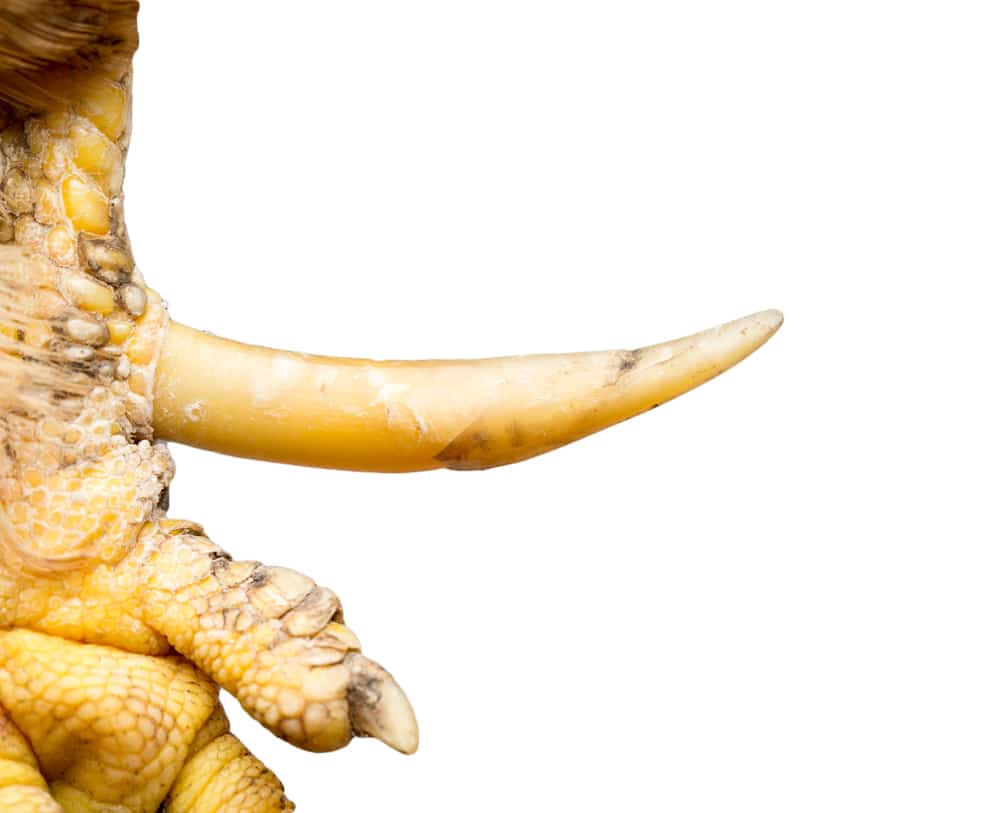
That’s not all, though. At the end of each “toe” is a super-sharp point that is covered in a hard layer of protein called keratin. This can be found on the beaks and bodies of other animals, too, including rhinoceros; they’re part of what gives roosters and several other creatures their terrifying, dinosaur-like appearances!
When roosters are still young, those spurs will not be visible. This is part of why it is so difficult to tell roosters and hens apart. A rooster’s spurs usually do not appear until the roosters are older – usually a few months or so.
Rooster spurs start out small and over time develop to goliath properties, become larger and harder until they are prominent features on your rooster’s bodies.
What’s interesting is that while spurs tend to be more violent-looking and more pronounced on roosters, there are many hens that have spurs, too. These spurs look a lot like those of roosters, especially very early on.
Why Do Roosters Need Spurs?
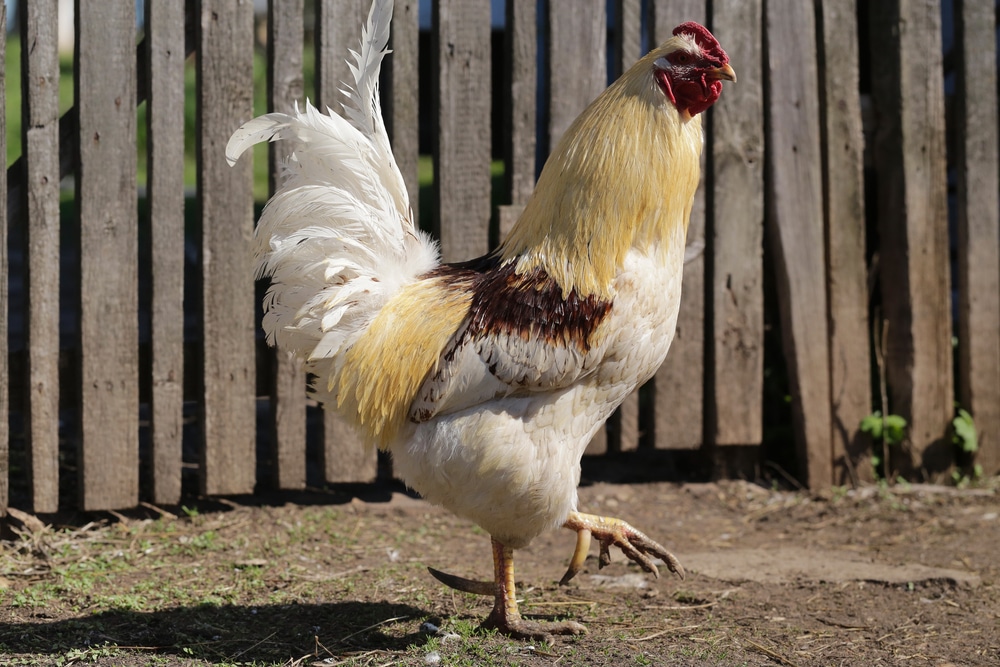
A rooster’s spurs serve several purposes for the bird. The main is personal and flock protection.
While the main purpose of a hen is to lay eggs and produce, the main purpose of a rooster is to protect his girls. Rooster spurs are incredibly sharp – you know this if you’ve ever been attacked by a rooster – and they can (and are!) used as weapons.
Roosters don’t discriminate who they go after with their spurs. From predators like cats, dogs, hawks, and weasels to even other roosters, spurs are the weapon of choice in a backyard flock.
In fact, roosters often fight each other with their spurs. This is very commonly done in disagreements over hens. The fights can also occur as several roosters are working out their places in a pecking order or over resources like food and space.
Often, you can reduce the incidence of these cockfights by making sure you have plenty of space for your birds. You can also ensure that there is a proper hen to rooster ratio, which will reduce the sex-related squabbles.
The Dangers of Rooster Spurs
Although there are several very important, and very valid, reasons for roosters having spurs, they also present several risks.
Rooster spurs Can Harm Humans
First and foremost, roosters that have long, sharp spurs can injure you or your family members. While most roosters will leave humans alone, especially if unprovoked it is not uncommon to find a rooster that is just downright ornery. When aimed correctly, a spur can inflict a nasty cut.
They Can Harm Your Rooster
Not only that, but a rooster with long spurs can actually hurt himself, too. It’s just like having long, jagged fingernails. If you let your fingernails grow too long, you may find that they snag on things and break easily.
They Can Get Stuck on Objects
Similarly, having a long set of rooster spurs can cause your rooster to get stuck on things. If he can’t get out in time, he could become the victim of an opportunist predator. Spurs don’t always grow evenly and uniformly, either, so it’s not uncommon for a spur to rub against a rooster and cause him wounds and infections.
Flock Members Could Be at Risk
Roosters can hurt other members of the flock with their spurs, too. Sometimes, this is intentional. Roosters will fight each other to determine and maintain the pecking order. While sometimes these squabbles are hot lived, other times, the matches lead to the death of one or both roosters.
They can hurt hens, too. Especially if the rooster’s spurs are allowed to grow long or jagged, they can hurt hens during mating. Rooster spurs that have grown unruly can injure your hens, leading to a risk for greater injury as the open wounds invite other chickens to engage in picking behaviors.
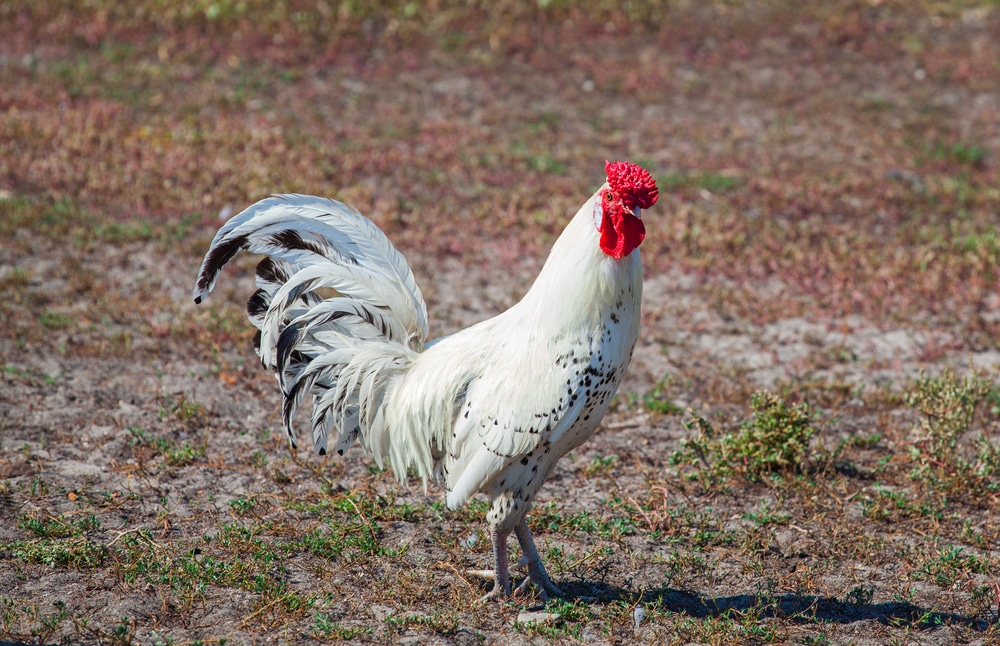
Removing Rooster Spurs
Lots of people decide to remove the spurs of their roosters. This is something that is highly controversial and is not always a great idea, depending on how it is done.
If you do decide to remove the scars of your rooster, you need to be incredibly careful in doing so. A spur, after all, is composed of bone, so if you start to cut away with abandon, you have the potential to inflict some serious damage.
When your roosters are still chicks, a veterinarian can actually remove the spurs before they even develop. Of course, you’ll need to be able to identify your chicks as roosters and not hens, which can be a challenge in itself!
However, removing rooster spurs is easy at this age. A vet will use electrocautery to stop the developing cells of the spur papilla. Since the bone is not well-developed, the process is not painful and your chicken will require it easily. This is much easier than having a veterinarian permanently remove a rooster’s spurs later in life.
There are three main ways you can trim the spurs of a rooster.
Filing
Filing is one of the easiest and most common ways people remove the spurs of a rooster. This is done the same way you would file your own fingernails or the hooves of a horse. Usually, you’ll use some kind of a metal file but you can also use a mechanical Dremel tool with a sanding attachment.
All you’ll need to do in this process is grind the rooster spur down so that it is at less of a dangerous length. You may want someone else to help you with this, as your rooster might be hard to handle. You can calm him down by wrapping him in a towel, leaving just the rooster’s leg exposed that you need to work on.
When you file the spur of your rooster, try to stop long before you get to the bone. If you don’t, you could seriously injure your chicken.
Clipping
Clipping is another way you can remove rooster spurs. This is done more like you would trim the claws of your dog or cat. You’ll want to use a large set of clippers so that they fit all the way around the spur.
Make sure your clippers are nice and sharp, too. This will not only help your work pass by more quickly, but it is also safer for your rooster.
Again, you may want someone to help you while you clip the spurs of your rooster. Firmly hold the shank of the rooster and simply clip away at the top of the spur. Again, don’t cut to the bone.
The only disadvantage of removing rooster spurs in this way is that it’s easy to leave a jagged, uneven edge behind. To deal with this, you may want to use a metal file, which can round down and smooth the edges of the spurs for a neat, clean finish.
Be careful clipping the spurs of your rooster. If you trim too far – or if you use incorrect tools, like pet toenail clippers or wire cutters – you may cause the spur sheath to crack.
There are plenty of people who are successful in using wire cutters and toenail clippers to remove rooster spurs, but you’ll need to be a lot more delicate in doing so. Always remember to take smaller pieces at once rather than large chunks. You can always take more off, but you can’t put any back!
Sheath Removal
Without veterinarian intervention, there is one other way you can remove or trim the spurs of your rooster. There are no sharp tools necessary, so the sheath removal methods are actually a bit safer than the two aforementioned methods.
It does, however, require a bit more finesse as there are more steps involved.
You’ll need a potato to do this. Microwave a potato for about ten minutes, then insert the rooster spur into the potato. Don’t let the flesh touch your rooster’s shank as it can burn him. Then, let the tomato sit on the spur for about three minutes. Both the moisture and the heat will soften the sheath that sits on top of the bone.
If done correctly, this can also be quite relaxing for your rooster!
Take the potato off the rooster spur and then grasp the spur with a pair of pliers. Twist the pliers and pull. The sheath should come right off. Plus, you can feed your chickens the cooked potato after for a tasty, nutritious snack! Call it even?
Contact a Vet
You can always have the rooster spur removed professionally. You’ll never have to worry about it growing. However, for this, you will likely need the assistance of a veterinarian who is skilled in these matters.
If you do decide to trim or remove the spurs of your rooster, consider the conditions in which you are raising your bird. A rooster that is mostly left to his own defenses in a free-range environment should be allowed to keep his spurs. Why? He needs them for self-defense.
Just as it’s considered unethical to declaw cats that live most of their lives outdoors, so, too, is it not exactly humane to remove the spurs of a rooster who needs them for protection. Allowing your rooster’s spurs to stay intact is a great way to reduce predator problems on your farm.
In most cases, just a light trim here or there is enough to keep the spur under control. As long as you keep it short and maintained, it’s less likely that it will be used to injure you, another rooster, or even a hen by mistake.
Other Tips for Dealing With Roosters
You may need to remove spurs if your rooster is aggressive and mean by nature, and frequently go after other animals, children, or visitors to your farm. Just keep in mind that he still may act out his violent tendencies in other ways and still might harass other people and animals – so removing the rooster spur might not be the ideal or perfect solution.
Therefore, you’ll want to consider some of the other reasons for chicken aggression – as well as how those behaviors are manifested in a flock.
Should You Keep Roosters?
There are lots of benefits to keeping roosters in a flock, many of which people tend to overlook in favor of just keeping half a dozen hens here or there.
While you obviously can’t keep roosters if your city’s ordinances don’t allow it, if you’re able to keep a rooster know that it’s a great way to keep your flock safe and healthy. Roosters are great providers and protectors of hens, and will alert the girls both when they find something tasty to eat as well as when there is a threat nearby.
Most roosters, as long as they have docile personality, won’t ever go after you with their spurs, anyway. In order to reduce these violent behaviors, look for roosters from good, calm breeding stock. There are certain breeds of chickens that are known for being more docile, as well as those that tend to be more aggressive.
This varies by breed, though, of course. Not every rooster is going to be level headed, even if all the other members of the same breed in the flock are.
Preventing Rooster Attacks
Some people swear by training their roosters from hatching to be docile and friendly toward humans. Usually achieved by spending lots of time handling your birds and feeding lots of treats, it does sometimes work. However, it can sometimes have a detrimental effect in that it can make your rooster less wary of actual predator threats, too.
One of the easiest ways to prevent rooster attacks is to provide for all of your chickens’ basic needs. Make sure you have plenty of space for your chickens and again, keep an adequate hen to rooster ratio.
The recommended number of hens to roosters is ten to twelve hens for each rooster. This can help prevent in-fighting as roosters fight each other over hens. Fighting can still occur – especially if your roosters tend to pick favorite hens – but it will be much less likely.
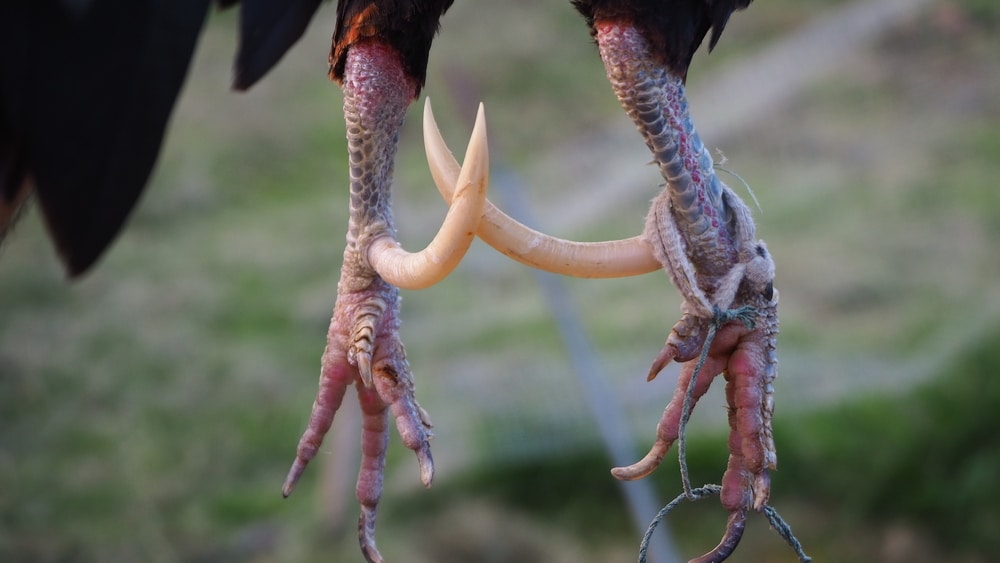
Do All Roosters Have Spurs?
If allowed to grow to full sexual maturity, then yes, all roosters will, unfortunately (or fortunately, depending on your perspective) develop spurs.
However, there are some breeds that are more likely to develop longer spurs. Larger chicken breeds, for instance, may have more pronounced rooster spurs.
Again, hens can also develop spurs. These aren’t found on all hens or even all hens of certain breeds. However, they are more common on certain breeds of chickens. Top contenders include Mediterrian fowl like Menorca, Leghorn, Polish, Ancona, and Sicilian Buttercup chickens.
How to Make the Most of a Rooster with Spurs
If you decide to let your rooster keep his spurs, there are a few tips you should keep in mind to make sure we stay safe and un-spurred!
For the most part, a rooster is unlikely to attack you. There are some naturally mean roosters, of course, just like there are naturally aggressive people. Therefore, you’ll want to watch the individual personality of your rooster with care, making sure you pay attention to his quirks and what tends to set him off.
When you interact with your rooster, pay attention to your movements. Don’t turn your back on him and don’t bend down near him, either. Never get your head or neck close to those spurs! You should also wear long pants wherever you go into the chicken yard to give him as little bare skin as possible to injure.
Some people even have gear that they take into the coop to protect them – this could be a stick or even a shovel. You don’t necessarily have to use it, but having something long to swat away a potential attack can be helpful and comforting.
You can take additional comfort in knowing that most roosters won’t attack as long as their basic needs are being met and you are cautious about how you approach them. Move slowly and make sure you provide plenty of food and water. Ensure a clean, safe coop and run, and of course, make sure your rooster has plenty of hens.
If a rooster can surround himself with his ladies and he feels safe and secure, then nine times out of ten, you won’t have to worry about those spooky-looking spurs at all.
Frequently Asked Questions
Keepers who have never heard of rooster spurs before might have a lot of questions. So, here are some answers to help you raise your flock.
What Should You Do if a Rooster Scratches You?
If a rooster scratches you, whether it’s with their spurs, claws, or beak, you should wash the wounds right away. Monitor the wounds, and if anything seems unusual, contact a medical professional. If the rooster that attacked you seems ill, it’s best to visit a doctor right away just to be safe.
Is it Inhumane to Remove Rooster Spurs?
Many people consider it inhumane to fully remove rooster spurs because they’re similar to nails on a dog or cat. The spurs have a “quick” in them, and cutting into the quick will damage tissue, cause bleeding, and be painful to the roosters. So, it’s much better for your rooster if you choose humane ways to trim the spurs rather than removing them completely.
The only reason a vet may agree that spur removal is necessary is if the spurs are growing toward the rooster’s foot and hurting them. Otherwise, spurs are natural parts of roosters that can be maintained.
When Do Roosters Start Showing Aggressive Behaviors?
Not all roosters are aggressive, but many of them may start showing protective behaviors at about four months old. They’re most likely to act aggressive if they’re protecting hens, so it’s best to have a limited number of roosters on your property. However, the rooster’s species can affect how fast they mature.
Final Thoughts
If you have roosters in your flock, you’re going to have to deal with rooster spurs. Yet, what you choose to do with the spurs is entirely up to you. If you’re worried about an aggressive rooster and the pain their spurs could cause, you may want to find ways to manage them. On the other hand, you can leave alone them if you don’t want to deal with the hassle of trimming them.
Many keepers only keep chickens for egg-laying rather than producing chicks. If that’s the case, you don’t need to keep roosters at all, which means you won’t have to worry about rooster spurs. Ultimately, all these decisions depend on what you’re raising the birds for.
